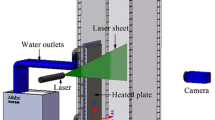Abstract
The variable interval time-averaging (VITA) technique is applied to the hot-wire measurements made in three axisymmetric, transitional hypersonic boundary layers. The average duration of conditionally sampled events is used to detect the transition region. It is found that the stability Reynolds number at the peak in the average duration of conditionally sampled events correlates well with the stability Reynolds number that is intermediate to the onset of transition and peak heating. This VITA-identified location of transition moves upstream under the effects of both an adverse pressure gradient and wall cooling; this agrees with previous experimental and computational studies. The VITA technique, therefore, offers an alternative method to obtain details of the location of transition in hypersonic stability experiments, in which hot-wire measurements of the transitioning boundary layers are made.










Similar content being viewed by others
References
Blackwelder RF, Kaplan RE (1976) On the wall structure of the turbulent boundary layer. J Fluid Mech 76:89–112
Blanchard AE, Selby GV (1996) An experimental investigation of wall-cooling effects on hypersonic boundary-layer stability in a quiet wind tunnel. NASA CR 198287
Bogard DG, Tiederman WG (1986) Burst detection with single-point velocity measurements. J Fluid Mech 162:389–413
Chokani N (1999) Nonlinear spectral dynamics of hypersonic laminar boundary layer flow. Phys Fluids 11:3846–3851
Chokani N (2005) Nonlinear evolution of Mack modes in a hypersonic boundary layer. Phys Fluids 17(1):014102
Chokani N, Bountin DA, Shiplyuk AN, Maslov AA (2005) Nonlinear aspects of hypersonic boundary layer stability on a porous surface. AIAA J 48:149–155
Doggett GP, Chokani N, Wilkinson SP (1997) Effects of angle of attack on hypersonic boundary layer stability in a quiet wind tunnel. AIAA J 35:464–470
Johansson AV, Alfredsson PH (1982) On the structure of turbulent channel flow. J Fluid Mech 122:295–314
Kendall JM (1975) Wind tunnel experiments relating to supersonic and hypersonic boundary-layer transition. AIAA J 13:290–299
Kimmel RL, Demetriades A, Donaldson JC (1996) Space–time correlation measurements in a hypersonic transitional boundary layer. AIAA J 34:2484–2489
Lachowicz JT, Chokani N (1996) Hypersonic boundary layer stability experiments in a quiet tunnel with bluntness effects. NASA CR 198272
Lachowicz JT, Chokani N, Wilkinson SP (1996) Hypersonic boundary layer stability over a flared cone in a quiet tunnel. AIAA J 34:2496–2500
Lu SS, Willmarth WW (1973) Measurement of structure of the Reynolds stress in a turbulent boundary layer. J Fluid Mech 60:481–511
Mack LM (1984) Boundary-layer stability theory. In: Michel R (ed) Special course on stability and transition of laminar flow, AGARD report no. 709
Malik MR (2003) Hypersonic flight transition data analysis using parabolized stability equations with chemistry effects. J Spacecraft Rockets 40:332–344
Manning ML, Chokani N (2004) Computational evaluation of quiet tunnel hypersonic boundary-layer stability experiments. J Spacecraft Rockets 41:406–415
Mumford JC (1982) The structure of the large eddies in fully developed turbulent shear flow. Part I. The plane jet. J Fluid Mech 118:241–268
Pate SR (1978) Dominance of radiated aerodynamic noise on boundary-layer transition in supersonic/hypersonic wind tunnels. Arnold Engineering Development Center technical report, AEDC-TR 77–107
Robinson SK (1986) Space-time correlation measurements in a compressible turbulent boundary layer. AIAA paper 86-1130
Sarma GR (1998) Transfer function analysis of the constant voltage anemometer. Rev Sci Instr 69:2385–2391
Spina EF, Smits AJ (1987) Organized structures in a compressible turbulent boundary layer. J Fluid Mech 182:85–109
Spina EF, Donovan JF, Smits AJ (1991) On the structure of high-Reynolds-number supersonic turbulent boundary layers. J Fluid Mech 222:293–327
Stetson KF, Thompson ER, Donaldson JC, Siler LG (1983) Laminar boundary layer stability experiments on a cone at Mach 8. Part 1: sharp cone. AIAA paper 83-1761
Weiss J, Chokani N, Comte-Bellot G (2005) Comparative use of constant-temperature and constant-voltage anemometers in a Mach 2.54 flow (in press)
Acknowledgement
The author gratefully acknowledges support from AFOSR under grant no. F49620-01-1-0105.
Author information
Authors and Affiliations
Corresponding author
Rights and permissions
About this article
Cite this article
Chokani, N. VITA measurements of transition in transitional hypersonic boundary layer flows. Exp Fluids 38, 440–448 (2005). https://doi.org/10.1007/s00348-004-0923-y
Received:
Revised:
Accepted:
Published:
Issue Date:
DOI: https://doi.org/10.1007/s00348-004-0923-y




